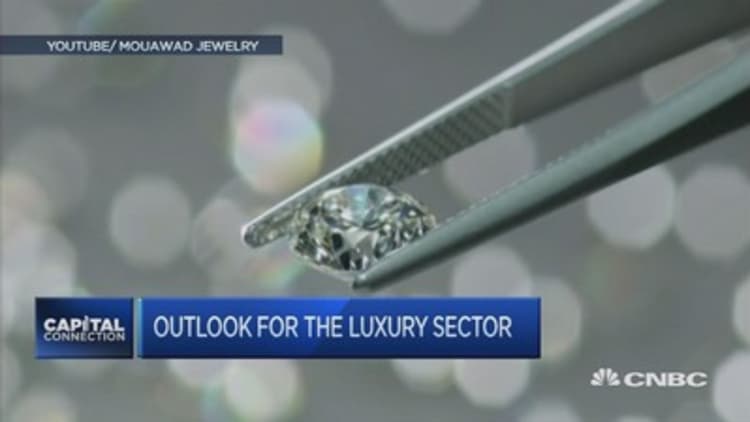Lost in all the talk about the jump in U.S. stocks since Donald Trump's election as president is one oddity: luxury goods stocks. This sector might logically be expected to benefit from Trump's celebration of material success and, more importantly, his promised $6 trillion tax cut. After George W. Bush came into office in 2002 and cut taxes on the rich, luxury stocks rose, though the greatest gains came during Bush's second term. The luxury boom came crashing down in 2008 — along with everything else — but the luxury index has tripled since 2009.
So why are luxury goods stocks mostly being left out of the Trump stock market party?
The numbers are simple enough. The S&P 500 luxury goods index has barely budged since the election, rising only 0.7 percent, a quarter of the gain in the overall S&P 500 Index. Exchange-traded funds that focus on luxury goods — but are traded on overseas exchanges — haven't done much, either: The Amundi ETF S&P Global Luxury UCITS ETF denominated in euros is down 2.6 percent since Nov. 8, while its dollar-denominated counterpart, the Amundi ETF S&P Global Luxury UCITS ETF USD, is down 0.7 percent.
Other domestic ETFs, such as State Street's $10 billion Consumer Discretionary Select Sector SPDR Fund, hold luxury stocks as part of broader exposure to the consumer-good sector, and they have benefited from the market optimism. It is up 6 percent in the past month, a bigger gain than the S&P 500. And the Consumer Discretionary Select Sector took in more than $1 billion in net flows from investors in November, the fourth most-popular sector bet in the month of November. Consumer discretionary stocks — many of which are also constituents within the luxury index — hit a 52-week high on Wednesday.
| YTD | November | 1-year | 3-year | 5-year |
|---|---|---|---|---|
| 0.55 | 0.61 | -3.38 | -2.86 | 8.04 |
(S&P Global Luxury Index performance, S&P Dow Jones Indices)
For the luxury sector, the realities are a little more complicated: Luxury goods companies aren't all alike. They have different products, different problems and different economics. The top 10 holdings in the luxury ETFs are as different as car makers BMW and Mercedes and clothing companies such as Michael Kors and PVH, owner of the Tommy Hilfiger and Calvin Klein brands.
Some of them, such as PVH, are thriving, while others are dealing with internal problems, including a restructuring at Ralph Lauren earlier this year that hurt 2016 results with one-time charges but is expected to boost profits beginning next year.
"The relation to the election is not as direct as with the banks," said Tuna Amobi, a consumer analyst at CFRA Research in New York. "But there is a reason to expect some correlation."
Global headwinds
Global trends, especially in Asia and Europe, are other drivers.
The biggest macro problems luxury goods makers face is slack tourism to the United States from countries that are going through economic problems of their own, Amobi said. For many luxury companies, problems in Brazil and wariness about China now weigh more heavily in investors minds than the prospect of a tax bill that the Tax Policy Center says could boost the after-tax income of the top 1 percent of highest-earning Americans by 14 percent.
Brazilian tourists, and to some extent Chinese visitors, are cutting back on the suitcase-lugging trips to New York-area flagship stores and malls that are a familiar sight in and around Manhattan. This slowdown was backed up by Michael Kors CEO John Idol on the company's third-quarter earnings call.
More from Portfolio Perspective:
Trump win leads to record ETF flows
4 winning investment moves for the Trump low-tax era
How president-elect Trump's plans will impact your year-end money moves
"Our results continued to be impacted by the ongoing decline in mall traffic, the reduction in tourism in certain major cities, and our strategic decision to reduce … inventory in the U.S. wholesale channel," Idol said, announcing a quarter in which Kors topped analyst forecasts but issued guidance for later this year that was lower than expected.
Also, sales outside the United States are actually hampered by the so-called Trump effect, since a rising dollar makes U.S. goods more expensive abroad. "That's only gotten stronger since the election," Amobi said.

Across the industry, many companies are also struggling with excess inventories that are holding down profits. October saw what Goldman Sachs analyst Lindsay Drucker Mann called "the great inventory destocking" as producers cut back on shipments to retailers who had too much on hand already. While brands such as Louis Vuitton saw improvement heading into the fall, the stutter-step in U.S. retail sales generally early in the third quarter cut into retailers' profits and outlooks, she said.
That's especially true in handbags and athletic wear, two subsets of the luxury goods market that have come under pressure this year.
Kate Spade had a mixed third quarter, with Mann cutting her price target for the shares because heavy discounting cut into gross profit margins. Coach is also rated underweight at Morgan Stanley, where constant-currency sales fell across the board in the September quarter, in part because of weak tourism and because sales "rolled over in Japan," dropping 7 percent, Morgan Stanley analyst Kimberly Greenberger said.
"We estimate Kate Spade will end FY16 with [profits before interest and taxes] margins of 12 percent, significantly below its larger peers that average 20 percent," Mann said in a note to clients. "While we see this margin gap closing over time as Kate Spade better leverages scale, near-term challenges remain."
Sports giants Nike and Under Armour, both part of the luxury index some ETFs track, have had a rough year, as well. Nike stock is down almost 30 percent in the last year, with little change since the election, and Under Armour's loss of more than half of its value since last December includes a single-digit percentage dip since the election.
The sports companies face some investor fears that Trump's opposition to the Trans-Pacific Partnership trade deal will hurt their supply chains, but the bigger deal is a slow-to-clear inventory glut in athletic apparel — and for Under Armour, a flagship shoe endorsed by basketball star Stephen Curry that isn't taking off, Morgan Stanley analyst Jay Sole said.
"Retro" basketball sneakers remain the hot look so, from a fashion standpoint, the Curry 3 is not on trend," as well as being too expensive, Sole wrote in a report. "We believe U.S. basketball footwear must grow 70 percent year-over-year to meet the Street's fiscal 2017 sales expectation and increasingly doubt this will happen."
For investors who think tax cuts will ultimately benefit consumer spending and luxury sales, the best advice may be to look closely — and invest selectively — because a rising tide of spending may not lift all luxury boats.
— By Tim Mullaney, special to CNBC.com
Notable November gainers in luxury sector
| Company | Nov. return |
|---|---|
| Blue Nile | 15.43 |
| Callaway Golf | 19.1 |
| Wynn Macau | 20.82 |
| Movado | 28.69 |
| MGM China | 30.48 |
Top-performing S&P Global Luxury stocks year-to-date
| Company | Total Return YTD |
|---|---|
| MGM China | 77.21 |
| Wynn Macau | 62.14 |
| Galaxy Entertainment | 57.13 |
| Sands China | 51.46 |
| Wynn Resorts | 51.07 |
| Sotheby's | 49.84 |
| Las Vegas Sands | 48.53 |
| Inter Parfums | 45.57 |
| PVH | 44.82 |
| Chow Tai Fook Jewelery | 43.44 |
| Belmond | 41.58 |
S&P Global Luxury Index Top 10 holdings
| Company | Total Return YTD | Total Return November | Total Return One-Year | Total Return Three-year |
|---|---|---|---|---|
| Daimler | -13.36 | -6.75 | -21.82 | -10.48 |
| Diageo | -6.49 | -5.94 | -10.36 | -14.14 |
| LVMH Moët Hennessy Louis Vuitton | 20.77 | 0.87 | 11.68 | 13.9 |
| NIKE | -18.12 | -0.22 | -23.48 | 30.92 |
| Compagnie Financiere Richemont | -5.61 | 1.34 | -10.36 | -31.52 |
| BMW | -12.55 | -2.77 | -18.95 | -18.26 |
| Las Vegas Sands Corp. | 48.53 | 8.28 | 50.6 | -0.47 |
| Carnival Corporation | -0.77 | 5.42 | 4.61 | 53.57 |
| Pernod-Ricard | -6.55 | -10.99 | -6.26 | -2.66 |
| Tesla Motors | -22.57 | -4.21 | -17.75 | 48.81 |
(Source: S&P Global Market Intelligence, all data except November monthly through 12/06/2016)




